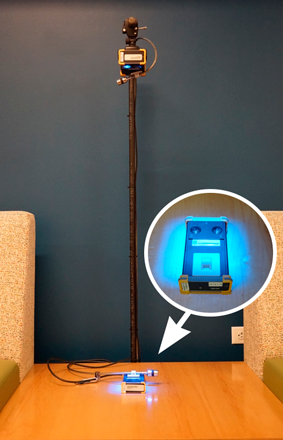Wireless
Raising the Bar for Open-Source Wi-Fi: TIP OpenWiFi Release 2.9 Validated

This week, CableLabs and the Telecom Infra Project (TIP), a global community of companies and organizations committed to developing improved infrastructure solutions for the Wi-Fi ecosystem, announced the successful validation of TIP OpenWiFi Release 2.9. CableLabs has also commissioned a refreshed OpenWiFi Community Lab to serve as a testing ground and demonstration stage for global cable operators.
TIP OpenWiFi is an open-source, community-developed, disaggregated Wi-Fi hardware and software system. As the cable industry seeks to accelerate Wi-Fi innovation and improved connectivity, this critical initiative supports the need for better networks and the growing adoption of Wi-Fi 6 devices across various applications.
Since OpenWiFi was launched in May 2021, CableLabs has supported the initiative with ongoing collaboration and R&D. This week’s announcement represents a new milestone in the pursuit of plug-and-play interoperability and moves the industry closer to the future of Wi-Fi.
Empowering Advanced Connectivity
TIP OpenWiFi is designed to lower the cost of developing and operating managed Wi-Fi networks, encourage suppliers and service providers to collaborate on development and integration, and improve choice and flexibility in Wi-Fi infrastructure.
As ecosystem stakeholders develop enterprise-grade Wi-Fi solutions, OpenWiFi creates strategic value by:
- Introducing diversity in the supply chain. With OpenWiFi, there’s no shortage of products because suppliers aren’t limited to one country, company or manufacturer.
- Eliminating vendor lock. By promoting openness in the Wi-Fi ecosystem, OpenWiFi makes it possible to mix and match products and suppliers to suit the specific needs of the Wi-Fi network.
With the launch of Release 2.9, OpenWiFi empowers advanced connectivity by supporting OpenRoaming, a roaming federation service from the Wireless Broadband Alliance that enables an automatic, secure global Wi-Fi experience. The new version is built on the uCentral communication layer and supports Multi Pre-Shared Key (MPSK), allowing devices to log in based on MAC address. It also supports a captive portal to require user interaction before they are granted Wi-Fi access.
“When OpenWiFi works seamlessly with OpenRoaming out of the box, it creates strategic business opportunities in verticals including retail, hospitality, education and multi-dwelling units,” said Tiago Rodriques, CEO of the Wireless Broadband Alliance. “It’s a smart move by the community developing and building the OpenWiFi solution to include OpenRoaming capabilities.”
Working Together to Accelerate Wi-Fi Innovation
In the brief time since OpenWiFi launched, there has been significant adoption by partners including NetExperience, VVDN Technologies, ActionTec and Edgecore Networks, as well as new global managed service providers (MSPs) and multiple-system operators (MSOs). Commercial deployments have seen success in the United States with Boingo Wireless, in India with Spectra, in Pakistan with Multinet, in Kenya with ThinkWiFi and Mawingu, and a trial with the City of Dublin and Virgin Media that complies with the European Commission’s WiFi4EU initiative, the benchmark for public Wi-Fi deployments in Europe.
Under TIP, OpenWiFi is a coordinated approach to openness within the Wi-Fi ecosystem. It brings together industry stakeholders, including corporations, industry alliances and open-source communities, to accelerate innovation and development of enterprise-grade Wi-Fi solutions. The system includes a cloud controller software development kit (SDK) and enterprise-grade access point (AP) firmware and is designed and validated so that these components work seamlessly together. Using standardized open APIs, the software platform allows APs to be managed from the cloud. A single codebase can be used on any compliant whitebox hardware, and developers can use the API to build innovative services on the cloud and target any device running on the OpenWiFi stack.
Test, Verify, Deploy
CableLabs’ OpenWiFi Community Lab offers CableLabs members who are building Wi-Fi networks the opportunity to demo, test, trial and ultimately deploy OpenWiFi. Companies participating in the trial and the OpenWiFi Lab include hardware manufacturers as well as software cloud controller companies: ActionTec, EdgeCore Networks, HFCL, Indio Networks, Lindsay Broadband and NetExperience.
“CableLabs has supported OpenWiFi since the launch, and we believe in the power of open and disaggregated Wi-Fi solutions,” said Josh Redmore, Principal Architect of Wireless Access Technologies for CableLabs. “This new version of OpenWiFi leverages open-source software and hardware to greatly reduce the barrier to entry of deploying managed Wi-Fi.”
Ongoing collaboration with TIP empowers the Wi-Fi ecosystem to center innovation and development on customer needs. As the leading innovation and R&D lab for the cable industry, CableLabs empowers research, development and testing for OpenWiFi, pointing the way toward innovations that will soon be standard in the cable industry. In collaboration with other industry stakeholders, CableLabs’ partnership with TIP aims to promote rapid development of OpenWiFi-based solutions that make possible the high-quality connectivity needed to underwrite ongoing innovation both now and in the future.
Stay up to date on TIP OpenWiFi and more by subscribing to our blog and visiting our Wi-Fi lab.

Reliability
Data Elements and TR-181 – Connect to the PNM Data You Need

Remote Wi-Fi troubleshooting is the keystone of good customer experience and reduced support costs. The ultimate iteration of this is a fully automated proactive network maintenance system, where Wi-Fi issues are resolved before they impact your customer. When Wi-Fi becomes self-healing, customers enjoy seamless access to your services. The first steps to enable this bright future have already been taken.
Wi-Fi CERTIFIED Data Elements™ Extends TR-181
Earlier this year, CableLabs led the effort in the Wi-Fi Alliance to build and launch Wi-Fi CERTIFIED Data Elements, which established a standardized data model to capture those key performance indicators necessary for remote Wi-Fi troubleshooting. Certifications are now available through Wi-Fi Alliance authorized test labs, and we anticipate the first Data Elements capable customer presence equipment in early 2020. But capturing this data is meaningless without a way to transport it out of the home. In September, the Broadband Forum helped us take the next major step by adopting Data Elements into TR-181.
TR-181 is a device data model that encompasses a variety of CPE configuration and monitoring parameters and has been very successful in the remote configuration of cable modems. Data Elements extends TR-181 to the Wi-Fi domain with meaningful, actionable information that is specifically targeted at remote troubleshooting. This includes layer 1 & 2 information from attached client devices and neighboring networks, giving you an unprecedented view deep into your customer’s network and beyond. Normally, we think of remote troubleshooting data as covering only the gateway’s perspective. By capturing and analyzing the behavior of the attached clients, you can identify and resolve long distance issues such as hidden nodes or external interference sources.
TR-181 with Data Elements is now available for both the widely-deployed TR-069 and USP – the next-generation advanced remote management utility.
Please contact Josh Redmore (j.redmore@cablelabs.com) for more information on how to get involved with Data Elements and TR-181.

Reliability
Now Announcing Wi-Fi CERTIFIED Data Elements™—Inventing the Standard in Wi-Fi PNM

Last year we announced that we’re working with the Wi-Fi Alliance to develop a standard for Key Performance Indicator (KPI) capture in a Wi-Fi network—now officially called Wi-Fi CERTIFIED Data Elements. Optimized and reliable residential Wi-Fi will be critical to deploying 10G and this standard addresses many of the major Wi-Fi PNM-related pain points identified by members of the cable community, such as the following:
- Lack of visibility into customers’ Wi-Fi networks: Often, MSOs must rely on their customers to report Wi-Fi problems after they've occurred, leading to customer dissatisfaction and retention issues.
- Exorbitant cost associated with Wi-Fi troubleshooting: The cable industry wastes more than over a billion dollars per year troubleshooting residential Wi-Fi and two thirds of customer complaints are related to Wi-Fi.
- Lack —or overabundance—of data: There’s currently no global standard for the collection of key actionable data on Wi-Fi network performance in residential, small and midsize businesses, and operator-managed enterprise systems. Data Elements offers a data model focused on what is important for troubleshooting.
- Lack of good options: Although proprietary Wi-Fi PNM solutions exist, they require deployment of costly proprietary technology on customers’ equipment and are too restrictive in terms of analytic capabilities.
The Ins and Outs of Wi-Fi CERTIFIED Data Elements™
Setting Up the Platform
Now that the Wi-Fi CERTIFIED Data Elements code has been released to the open source community, anyone can use it. There’s no proprietary equipment or other restrictions. Cable Internet providers can work with their vendors to get the code implemented on customers’ equipment (CPEs) and certified by the Wi-Fi Alliance. Once the equipment is in place and appropriate cloud servers have been set up, providers can begin to collect and analyze the incoming data.
Collecting the Data
Due to the dynamic nature of Wi-Fi, Wi-Fi CERTIFIED Data Elements focuses on a rapid collection of a few KPIs that are responsible for the majority of customers’ Wi-Fi issues. It supports scheduled and asynchronous data transmission that gives operators unprecedented visibility into customer Wi-Fi network performance without adversely affecting the quality of the connection.
Using the Data
In many cases, operators will be able detect and quickly fix Wi-Fi related issues remotely before customers even notice there’s a problem—saving both time and money that would otherwise be wasted on troubleshooting efforts later on. For example, if a Wi-Fi channel in an apartment building serviced by one MSO becomes too crowded, the system will have the data to automatically recommend a better channel distribution among all the apartments, proactively improving the experience for all the residents before they notice a “slowdown” in the connection. If a customer does report an issue, the support representative will be able to quickly pinpoint the source and offer actionable insights based on the data. For example, if the customer complains about “slow Internet,” the rep will be able to detect whether there’s a coverage problem in the home or whether the customer’s Wi-Fi device can actually support the Internet speed he or she is paying for.
What’s Next
Wi-Fi CERTIFIED Data Elements is a long-awaited solution to many Wi-Fi related issues. Not only will it significantly reduce the barrier to entry for any MSO looking to implement an effective Wi-Fi PNM system, it will also help cut troubleshooting costs and provide a better, more reliable Wi-Fi experience for residential and business customers. We are very excited about sharing this new technology with our members and vendors and are looking forward to its release later this year. Please stay tuned for updates!

Wireless
Wi-Fi Proactive Network Maintenance: Making Wi-Fi Frictionless, Invisible, and Reliable

The term Wi-Fi, coined by the Wi-Fi Alliance, is one of the most widely used and recognized technology terms in the world. That’s understandable when you consider facts like these:
- KPCBs Mary Meeker, in her highly regarded annual global internet survey, found worldwide Wi-Fi networks grew from 90 million in 2012 to 450 million in 2017—an incredible 500% growth in 5 years.
- Rakesh Taori, VP Systems and Standards at Phazr, says their research shows over 90% of travelers rate the availability of Wi-Fi as their #1 amenity when choosing a hotel.
Hotels, retailers, corporations, and others dependent on Wi-Fi networks understand its importance and value to their businesses. They are concerned with their Wi-Fi’s uptime availability and are eager to develop proactive network maintenance capabilities.
Proactive network maintenance (PNM) is a revolutionary philosophy. Unlike reactive or preventive maintenance, proactive maintenance depends on a constant and rigorous inspection of the network to look for the causes of a failure, before that failure occurs, and not treating network failures as routine or normal. PNM is about detecting impending failure conditions followed by remediation before problems become evident to users.
Multiple Systems Operators (MSOs) report that no standard exists currently to capture key performance data from residential Wi-Fi. Proprietary solutions exist, but the problem is they lock MSOs into deploying a specific agent onto the consumer premise equipment (CPE) and can be restrictive in terms of analytics availability. At CableLabs, we’re determined to change that.
Promising Wi-Fi PNM Field Trial
We created a proof of concept Wi-Fi PNM-enabled Access Point, which we then tested in a field trial involving 10 members in 7 countries and hundreds of millions of data points. The captured data demonstrated our ability to identify Wi-Fi issues remotely, such as poor coverage and time-based channel degradation. With this proven architecture, we successfully lobbied the Wi-Fi Alliance to create a task group around Wi-Fi PNM.
Wi-Fi Data Elements Vision
We’re working with the Wi-Fi Alliance and their members to create the global standard for KPI capture—called Wi-Fi Data Elements. These data elements form a standardized data model that encompass the key performance indicators (KPI's) of a Wi-Fi network. Our aim is the rapid collection of data necessary to respond to the dynamic nature of Wi-Fi in residential, small and midsize businesses, and operator-managed enterprise systems.
- Data—both a lack of and an overabundance—is holding up efforts to enact Wi-Fi PNM: Traditionally, cable operators have taken an all-or-nothing approach when polling information from a residential gateway, which means all MIBs or other data objects are polled at once. This could mean polling over 400 objects. As a result, operators minimize the number of device contacts, perhaps as infrequently as once a day.
- Wi-Fi is a very dynamic technology, requiring a rapid response: One way to deal with this infrequent polling is to focus the data collection on a few critical pieces of information. Sending this critical information through a framework that supports scheduled and asynchronous transmission of ONLY the critical information would support scalability.
- The majority of Wi-Fi support issues can be addressed by a handful of KPIs: An efficient framework would be one where data can be analyzed at high resolution and then distributed to OSS systems at a lower resolution. In home networks, this transmission would only occur in an exceptional condition.
- It’s important to collectively evaluate all data: Wi-Fi troubleshooting can’t be accomplished by looking at a single data point. WFA’s release plan addresses a solution for scalable and efficient Wi-Fi PNM data collection with options for event-driven data distribution.
CableLabs would like to facilitate better use of the DOCSIS 3.1 PNM capabilities to improve the effectiveness of the Data Elements architecture by creating a single repository for all PNM data, regardless of the source. The Wi-Fi Alliance Data Elements standard furthers that vision by allowing all CPE vendors to supply the same data.
Subscribe to our blog for further updates here or at the Wi-Fi Alliance website to see how Wi-Fi Data Elements is moving forward to improve Wi-Fi availability through proactive network maintenance, making highly available Wi-Fi networks accessible for the millions of users depending on them.

Consumer
Li-Fi – A Bright Future for Home Networks

At CableLabs, we are continually researching new methods of in-home wireless network distribution, and one exciting new contender is Li-Fi.
What is Li-Fi?
Li-Fi is the modulation of a free-space beam of light in order to transmit a signal. It can be thought of as analogous to Wi-Fi, just in a much higher frequency band (430 – 770 THz vs. 2.4 GHz). We’ve actually been using this same basic concept for over 100 years, in the form of Morse code being transmitted from ship to ship via signal lamps.
The Shannon–Hartley theorem allows us to calculate the maximum bitrate of a communications channel with a specific bandwidth. Since capacity increases with bandwidth, we can immediately see the vast potential of Li-Fi, which has ~340 THz to work with in the visible light frequencies. Compare that with Wi-Fi, which has less than 1 GHz available and is able to provide over a gigabit per second, and you can see the potential for ultra-high speed in-home networks. As virtual and augmented reality achieve widespread adoption, these ultra-high speeds will become mandatory.
To give you an idea of just how large a difference this increase in bandwidth is, it’s close to the same difference between the mass of the Earth and the Sun!
Where are we going?
The ideal product is a Li-Fi enabled light bulb in the same form factor that consumers are used to now – and with the same ease of installation. Li-Fi could be a viable solution to improving the coverage and reliability of a home network by reusing existing light fixtures. Just screw the bulb in and you’ve expanded your network.
The other side of the connection is the endpoint device, and a number of consumer device manufacturers are beginning the process of integrating Li-Fi. Apple is exploring adding Li-Fi to their mobile devices, which is a natural product evolution, as the majority of smartphones already contain the two things needed for Li-Fi, a light detector (the camera) and a light emitter (the camera flash).
Where are we today?
CableLabs has fully functioning prototypes of a single-channel Li-Fi system, which have proved to achieve data rates of around 300 Mbps. It is free from Wi-Fi interference and simple to use. Currently the devices need to be directly in-line with each other, so research into improving the signal-to-noise ratio (SNR) is needed for us to achieve omnidirectional Li-Fi.
We’ve also done extensive research into the necessary backhaul systems that will make Li-Fi a useful reality, such as next-generation powerline networking, which uses your existing home electrical wiring as a network. By networking the Li-Fi bulbs together, you can achieve seamless, whole-home coverage. Anywhere there is light, there is connectivity.
The cable industry, with the introduction of DOCSIS 3.1 and beyond, continues to increase Internet connection speeds. These speeds are currently beyond what any current-generation in-home wireless system can handle, so research into technologies like Li-Fi will play a vital part in ensuring customers are able to fully utilize their connection.
Josh Redmore is the Lead Architect in Wireless Network Optimization group at CableLabs.
Follow him on Twitter.





